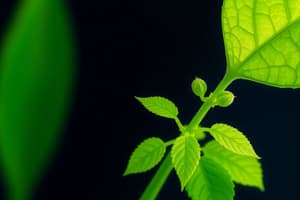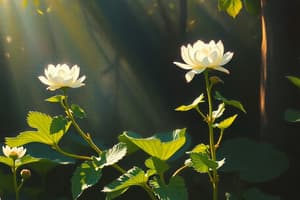Podcast
Questions and Answers
A photosystem consists of which of the following structures? (Select all that apply)
A photosystem consists of which of the following structures? (Select all that apply)
- Primary electron acceptor (correct)
- Light harvesting complexes (correct)
- Chlorophyll molecules (correct)
- Reaction-Centre Complex (correct)
The light reactions of photosynthesis supply the Calvin Cycle with ___________.
The light reactions of photosynthesis supply the Calvin Cycle with ___________.
ATP and NADPH.
Why do the reactions of the Calvin Cycle usually not occur at night?
Why do the reactions of the Calvin Cycle usually not occur at night?
The Calvin Cycle requires products only produced when the photosystems are illuminated.
In photosynthesis, plants use carbon from __________ to make sugar and other organic molecules.
In photosynthesis, plants use carbon from __________ to make sugar and other organic molecules.
What property of the pigment chlorophyll makes it appear green?
What property of the pigment chlorophyll makes it appear green?
Which process occurs during the second phase, the reduction phase, of the Calvin cycle?
Which process occurs during the second phase, the reduction phase, of the Calvin cycle?
How does carbon dioxide enter the leaf?
How does carbon dioxide enter the leaf?
The light reactions of photosynthesis occur in the __________.
The light reactions of photosynthesis occur in the __________.
During which process is molecular oxygen produced in photosynthesis?
During which process is molecular oxygen produced in photosynthesis?
The energy used to produce ATP in the light reactions of photosynthesis comes from ____________.
The energy used to produce ATP in the light reactions of photosynthesis comes from ____________.
The source of the oxygen produced by photosynthesis has been identified through experiments using radioactive tracers. The oxygen comes from __________.
The source of the oxygen produced by photosynthesis has been identified through experiments using radioactive tracers. The oxygen comes from __________.
Where does the Calvin Cycle of photosynthesis occur?
Where does the Calvin Cycle of photosynthesis occur?
Why could the Calvin Cycle not occur without the light reactions?
Why could the Calvin Cycle not occur without the light reactions?
Where do the electrons entering photosystem II come from?
Where do the electrons entering photosystem II come from?
The light reactions of photosynthesis use chemiosmosis to produce ATP that will be used in the Calvin Cycle. Across which structure(s) is the electrochemical gradient formed?
The light reactions of photosynthesis use chemiosmosis to produce ATP that will be used in the Calvin Cycle. Across which structure(s) is the electrochemical gradient formed?
Why are most autotrophs referred to as the producers of the biosphere?
Why are most autotrophs referred to as the producers of the biosphere?
What difference in carbon fixation exists between C3 and C4 plants?
What difference in carbon fixation exists between C3 and C4 plants?
What energy source did a philodendron use while in total darkness?
What energy source did a philodendron use while in total darkness?
Which of the following occurs during the Calvin Cycle?
Which of the following occurs during the Calvin Cycle?
Chlorophyll molecules are in which part of the chloroplast?
Chlorophyll molecules are in which part of the chloroplast?
G3P is used in which of the following processes? (Select all that apply)
G3P is used in which of the following processes? (Select all that apply)
In the light reactions of photosynthesis, ATP is produced by photophosphorylation. Which process is most similar to photophosphorylation?
In the light reactions of photosynthesis, ATP is produced by photophosphorylation. Which process is most similar to photophosphorylation?
Both mitochondria and chloroplasts _______________.
Both mitochondria and chloroplasts _______________.
The light reactions of photosynthesis generate high-energy electrons, which end up in __________. They also produce __________ and __________.
The light reactions of photosynthesis generate high-energy electrons, which end up in __________. They also produce __________ and __________.
During the Calvin Cycle, what happens during the carbon fixation phase?
During the Calvin Cycle, what happens during the carbon fixation phase?
When chloroplast pigments absorb light, ____________.
When chloroplast pigments absorb light, ____________.
What is the most important role of pigments in photosynthesis?
What is the most important role of pigments in photosynthesis?
Carbon dioxide and oxygen enter and exit a leaf by diffusion. Which structure(s) on a leaf allow(s) this process to happen?
Carbon dioxide and oxygen enter and exit a leaf by diffusion. Which structure(s) on a leaf allow(s) this process to happen?
In photosynthesis, what molecule is oxidised and what molecule is reduced?
In photosynthesis, what molecule is oxidised and what molecule is reduced?
Which of the following statements correctly distinguishes between autotrophs and heterotrophs?
Which of the following statements correctly distinguishes between autotrophs and heterotrophs?
Flashcards are hidden until you start studying
Study Notes
Photosystem Structure
- A photosystem consists of a Reaction-Centre Complex, Chlorophyll molecules, Light harvesting complexes, and a Primary electron acceptor.
Light Reactions and the Calvin Cycle
- Light reactions produce ATP and NADPH, which supply the Calvin Cycle.
- The Calvin Cycle requires ATP and NADPH generated by light reactions and typically does not occur at night due to dependency on light-induced products.
Carbon Source for Photosynthesis
- Plants utilize Carbon Dioxide to synthesize sugar and organic molecules.
Chlorophyll Properties
- Chlorophyll appears green because it reflects green light while absorbing other wavelengths from the visible spectrum.
Calvin Cycle Phases
- G3P is produced during the reduction phase of the Calvin Cycle.
Carbon Dioxide Entry
- Carbon dioxide enters leaves through stomata.
Location of Light Reactions
- Light reactions occur in the thylakoids of chloroplasts.
Oxygen Production
- Molecular oxygen is produced during the light reactions via linear electron flow.
ATP Production Mechanism
- ATP in light reactions is produced through the movement of H+ ions across membranes.
Source of Oxygen
- The oxygen generated in photosynthesis originates from water.
Calvin Cycle Occurrence
- The Calvin Cycle takes place in the stroma of chloroplasts.
Dependency of Calvin Cycle on Light Reactions
- The Calvin Cycle cannot occur without light reactions, as ATP and NADPH generated by the latter are essential for sugar production.
Electrons in Photosystem II
- Electrons entering photosystem II are sourced from water.
Chemiosmosis in ATP Production
- The thylakoid membrane forms an electrochemical gradient pivotal for chemiosmosis during ATP production.
Autotrophs as Producers
- Autotrophs are referred to as producers because they are the primary source of organic compounds for non-autotrophic organisms.
Carbon Fixation in C3 vs. C4 Plants
- In C4 plants, the first product of carbon fixation is a four-carbon compound, in contrast to the three-carbon compound in C3 plants.
Energy Source in Darkness
- A philodendron can survive in darkness by utilizing stored sugars or starch for energy.
Carbon Fixation in the Calvin Cycle
- During carbon fixation, CO2 is incorporated one molecule at a time to ribulose bisphosphate.
Excitation of Electrons in Pigments
- When chloroplast pigments absorb light, their electrons become excited.
Role of Pigments
- The primary role of pigments in photosynthesis is to capture light energy.
Diffusion of Gases
- Stomata enable the diffusion of carbon dioxide and oxygen into and out of leaves.
Redox Processes in Photosynthesis
- In photosynthesis, water is oxidized and carbon dioxide is reduced.
Distinction Between Autotrophs and Heterotrophs
- Autotrophs can nourish themselves starting from CO2 and inorganic nutrients, unlike heterotrophs.
Studying That Suits You
Use AI to generate personalized quizzes and flashcards to suit your learning preferences.




